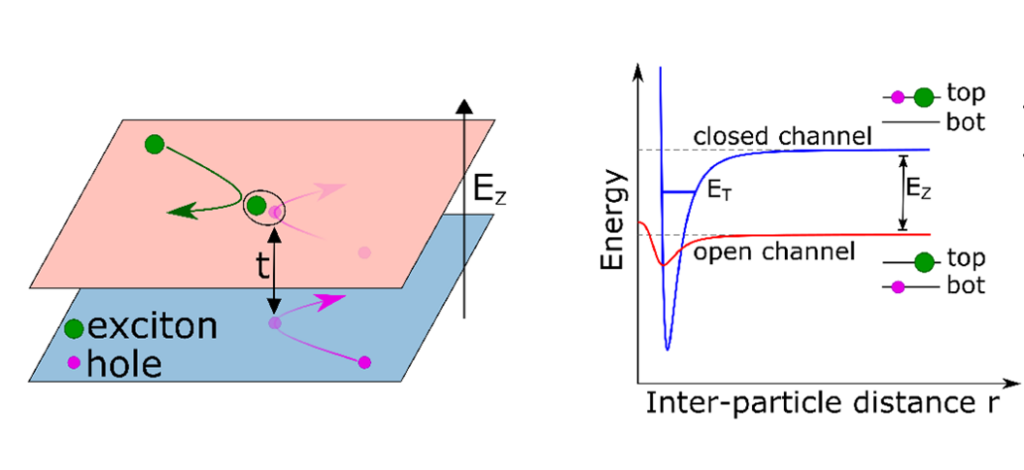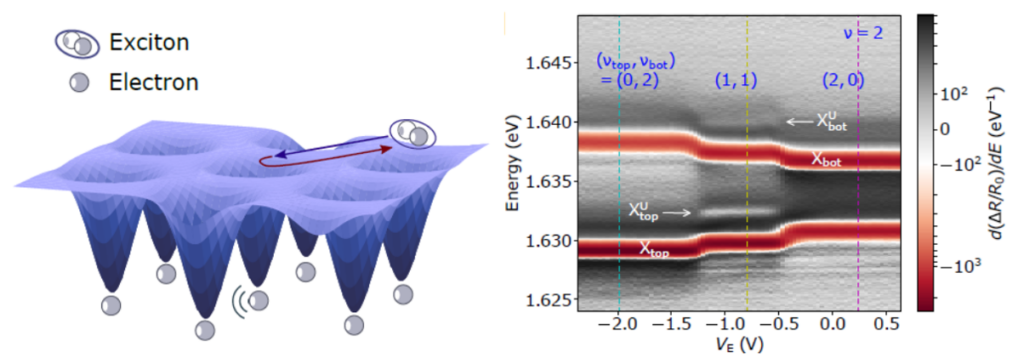Tunable Feshbach resonances in a bilayer semiconductor
Many quantum phases are achieved by controlling the sign and strength of interactions between particles. For example, one of the most common ways to tune the interactions between ultracold atoms, and therefore the many-body phase of the system, is by Feshbach resonances. Feshbach resonances allow tuning of the interaction strength between two particles by bringing their energies to resonance with a bound molecular state. In our work, we have used a two-dimensional bilayer made of MoSe2/hBN/MoSe2 to demonstrate a Feshbach resonance between an exciton (an electron-hole pair) in one layer and a hole in the other layer. When the optically excited exciton and the hole spatially overlap, and under the application of an appropriate electric field, the hole can tunnel between the two layers and form an interlayer exciton-hole, termed a “Feshbach molecule”. Adjusting the interactions between the exciton and hole using an applied electric field, might well become a versatile tool to study a broad range of two-dimensional many-body phenomena.

Read more:
- Schwartz, I., Shimazaki, Y., Kuhlenkamp, C., Watanabe, K., Taniguchi, T., Kroner, M., & Imamoğlu, A., Electrically tunable Feshbach resonances in twisted bilayer semiconductors. Science, 374, 336-340 (2021).
Probing charge order using optical excitons
Itinerant electrons (or holes) in doped two-dimensional semiconductors are dynamically screening optical excitons – bound pairs of an electron and a hole. When the itinerant electrons break translation symmetry and are periodically distributed in the plain, they generate a periodic potential that acts like a diffraction grating for the excitons. As a result of this potential, high-momentum excitonic states are scattered to zero-momentum states at higher energy, resulting in a new excitonic resonance. We observed the emergence of a new optical resonance attributed to the emergence of a spatially ordered Mott-like correlated electronic state. For that, we have used a two-dimensional bilayer sample made of MoSe2/hBN/MoSe2 with a small twist angle between the two TMD layers, resulting in a moiré potential for the electrons. A periodic electronic distribution occurs upon doping exactly one electron per moiré unit cell.

Read more:
- Shimazaki, Y., Kuhlenkamp, C., Schwartz, I., Smoleński, T., Watanabe, K., Taniguchi, T., Kroner, M., Schmidt, R., Knap, M., & Imamoǧlu, A., Optical Signatures of Periodic Charge Distribution in a Mott-like Correlated Insulator State. Physical Review X, 11, 021027 (2021).

